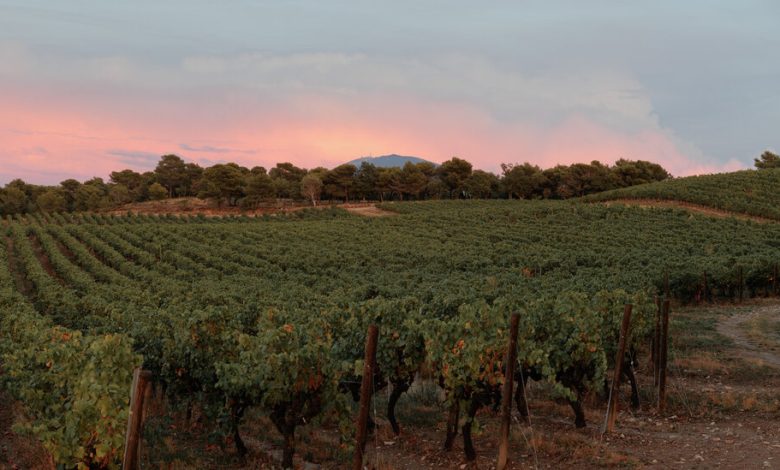In Provence, Winemakers Confront Climate Change

“You can taste the climate change.”
Frédéric Chaudière, a third-generation winemaker in the French village of Mormoiron, took a sip of white wine and set down his glass.
The tastes of centuries-old varieties are being altered by spiking temperatures, scant rainfall, snap frosts and unpredictable bouts of extreme weather. The hellish summer was the latest reminder of how urgently the $333 billion global wine industry is being forced to adapt. Temperature records were set in Europe, the United States, China, North Africa and the Middle East as hail, drought, wildfires and floods on a biblical scale inflicted damage.
Grape vines are some of the most weather-sensitive crops, and growers from Australia to Argentina have been struggling to cope. The imperative is particularly great in Europe, which is home to five of the world’s top 10 wine-producing countries and includes 45 percent of the planet’s wine-growing areas.

Chêne Bleu is one of the highest vineyards in Provence, France. Winegrowers have been increasingly searching for higher altitudes for cooler temperatures.
Mr. Chaudière is the president of an association of wine producers in Ventoux. His winery, Château Pesquié, is in the Rhône Valley, where the impact of climate change over the past 50 years on winegrowers has been significant.
The first burst of buds appear 15 days earlier than they did in the early 1970s, according to a recent analysis. Ripening starts 18 days earlier. And harvesting begins in late August instead of mid September. Change was expected, but the accelerating pace has come as a shock.
For many vineyards, the new weather patterns are resulting in smaller grapes that produce sweeter wines with a higher alcohol content. These developments, alas, are out of step with consumers who are turning to lighter, fresher tasting wines with more tartness and less alcohol.
For other vineyards, the challenges are more profound: Dwindling water supplies threaten their existence.
How to respond to these shifts, though, is not necessarily clear.

A harvester clipping clusters by hand and dropping them into round baskets, which are then moved into trucks.CreditCredit…

CreditCredit…
Emergency irrigation, for example, can save young vines from dying when the heat is scorching. Yet over the long haul, access to water near the surface means the roots may not drill down deep into the earth in search of the subterranean water tables they need to sustain them.
Chêne Bleu, a small and relatively new family winery on La Verrière, the site of a medieval priory above the village of Crestet, is one of the region’s leaders in developing adaptations for cultivation and processing that are regenerative and organic.
“We’re all going to get whacked by similar weather challenges,” said Nicole Rolet, who inaugurated the winery in 2006 with her husband, Xavier.
In her view, there are two responses to climate change: You can fight it with chemicals and artificial additives that battle nature, she said, or “you can create a balanced functioning of the ecology through biodiversity.”
The natural approach was on display one morning as harvesters slowly inched down the rows of vines, clipping plump purple clusters of Grenache grapes by hand.
Stationary wooden pickets have been replaced by a trellising system that can be adjusted upward as vines grow so that their leaves can be positioned to serve as a natural canopy to shade grapes from a burning sun.
Between the rows, grasses blanket the ground. They are just some of the cover crops that have been planted to help manage erosion, retain water, enrich the soil, capture more carbon and control pests and disease.
Scientists have found that expanding the variety of plants and animals can reduce the impact of shifting climate on crops, highlighting, as one study put it, “the critical role that human decisions play in building agricultural systems resilient to climate change.”



Surrounding Chêne Bleu’s emerald fields are wildflowers, a wide range of plant species and a private forest. There is a bee colony to increase cross-pollination and a grove of bamboo to naturally filter water used in the winery.
Sheep provide the manure for fertilizer. The vineyard also dug a muddy pool — nicknamed the “spa” — for roaming wild boar, to lure them away from the juicy grapes with their own water supply.
The Rolets have teamed up with university researchers to experiment with cultivation practices. And they are compiling a census of animal and plant species, including installing infrared equipment to capture rare creatures like a genet, a catlike animal with a long, ringed tail.
“People are formally and informally doing experimental work, promoting best practices,” Ms. Rolet said, as she sat in a grand dining hall topped by stone archways at the restored priory. “It’s surprisingly hard to do.”
“No one has time or money to take nose off the grindstone to look at what someone is doing on the other side of the world,” she explained.

Harvesters sifting through grapes on a conveyor belt in the winery, looking to pick out stray leaves or bad grapes.CreditCredit…

CreditCredit…
At the winery, the morning’s harvest is emptied onto a conveyor belt, where workers pick out stray leaves or damaged berries before they are dropped into a gentle balloon press. The golden juice drips down into a tray lined with dry ice, producing vaporous swirls and tendrils. The ice prevents bacterial growth and eats up the oxygen that can ruin the flavor.
Chêne Bleu has several advantages that many neighboring vineyards don’t. Its 75 acres are relatively isolated and located in a Unsesco biosphere reserve, a designation aimed at conserving biodiversity and promoting sustainable practices. Because it is situated on a limestone outcropping on the ridge of a tectonic plate, the soil contains ancient seabeds and a rich combination of minerals. And, at 1,600 feet, it is one of the highest vineyards in Provence.
Winegrowers have been increasingly searching for higher altitudes because of cooler nighttime temperatures and shorter periods of intense heat. In Spain’s Catalonia region, the global wine producer Familia Torres has in recent years planted vineyards at 3,000 to 4,000 feet up.
Chêne Bleu has other resources. Mr. Rolet, a successful businessman and former chief executive of the London Stock Exchange, has been able to finance the vineyard’s cutting edge equipment and experiments. A larger marketing budget enables the vineyard to take chances others might not want to risk.
The Rolets, for example, chose to sometimes bypass traditional appellations — legally defined and protected wine-growing areas — to experiment with more varieties for their high-end offerings.
Although the wine map has changed, France’s strict classification system has not. Appellations were instituted decades ago to ensure that buyers knew what they were purchasing. But now, those definitions can limit the type of varieties that farmers can use as they search for vines that can better withstand climate change.

The juice drips down into a tray lined with dry ice, which prevents bacterial growth and eats up the oxygen that can ruin the flavor.CreditCredit…
“There is a big, frustrating lag time between what the winemakers are experiencing and what the authorities are doing,” said Julien Fauque, the director of Cave de Lumières, a cooperative of roughly 50 winegrowers who farm 450 hectares of land in the Ventoux and Luberon areas.
Climate change may mean that growers must reconsider once unthinkable practices.
Adding tiny amounts of water could reduce the alcoholic content and prevent fermentation from stalling, he said, but the practice, strictly forbidden across the European Union, could land a winemaker in prison. California, by contrast, allows such additions.
There is flexibility in the system, said Anthony Taylor, the director of communications at Gabriel Meffre in Gigondas, one of the larger wineries in southern Rhône. But “they’re on a wire,” he said of official regulators. “They want to preserve as much as possible a profile that is successful, and they’re also listening to the other side, which argues we need to change things or introduce new varieties.”
The pace of change, though, is accelerating, Mr. Taylor said: “The speed at which we’re moving is quite frightening.”



